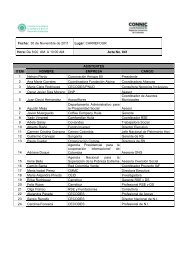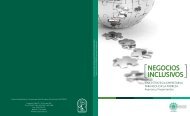Setting new standards - Friends Life
Setting new standards - Friends Life
Setting new standards - Friends Life
Create successful ePaper yourself
Turn your PDF publications into a flip-book with our unique Google optimized e-Paper software.
FINANCIAL STATEMENTS<br />
IFRS FINANCIAL STATEMENTS<br />
EEV SUPPLEMENTARY INFORMATION<br />
Notes to the consolidated accounts continued<br />
1. Accounting policies continued<br />
settlement of the carrying amount of the assets and liabilities. The<br />
tax rates used are the rates that have been enacted or substantively<br />
enacted by the balance sheet date.<br />
Deferred taxation is recognised in the income statement for the<br />
period, except to the extent that it is attributable to a gain or loss<br />
that is recognised directly in equity. In this case the gain or loss is<br />
shown net of the attributable deferred tax.<br />
Deferred tax liabilities are generally recognised for all taxable<br />
temporary differences and deferred tax assets are recognised to the<br />
extent that it is probable that taxable future profits will be available<br />
against which deductible temporary differences can be utilised.<br />
The carrying amount of deferred tax assets is reviewed at each<br />
balance sheet date and reduced to the extent that it is no longer<br />
probable that sufficient future taxable profits will be available to<br />
allow all or part of the asset to be recovered.<br />
1.3.16 Insurance and other receivables<br />
Insurance and other receivables are recognised when due and<br />
measured on initial recognition at the fair value of the amount<br />
receivable plus incremental costs. Subsequent to initial recognition,<br />
receivables are measured at amortised cost using the effective<br />
interest rate method.<br />
The carrying value of receivables is the present value of estimated<br />
future cash flows discounted at the original effective interest rate.<br />
1.3.17 Cash and cash equivalents<br />
Cash and cash equivalents include cash in hand, deposits held at call<br />
with banks, other short-term highly liquid investments with original<br />
maturities of three months or less, and bank overdraft facilities, where<br />
there is a legal right of offset against cash and cash equivalents.<br />
1.3.18 Insurance contracts<br />
Insurance contracts are measured using accounting policies<br />
consistent with those previously adopted under the Modified<br />
Statutory Solvency (MSS) basis, as amended following the adoption<br />
of the principles contained in FRS 27 <strong>Life</strong> Assurance.<br />
Insurance contract liabilities are determined separately for each life<br />
operation following an annual investigation of the long-term funds at<br />
31 December. For UK operations the liabilities are calculated in<br />
accordance with the relevant Financial Services Authority (FSA) rules<br />
contained in the Prudential Sourcebook for Insurers. For overseas<br />
operations, insurance contract liabilities are calculated on recognised<br />
actuarial principles, based on local regulatory requirements. The<br />
valuations are subject to adjustments to reflect relevant accounting<br />
requirements as set out below.<br />
For the conventional with-profits business in <strong>Friends</strong> Provident <strong>Life</strong><br />
and Pensions Limited (FPLP), the liabilities to policyholders are<br />
determined in accordance with the Realistic Balance Sheet (RBS)<br />
regulations and in accordance with the principles contained in<br />
FRS 27. These liabilities include both declared and constructive<br />
obligations for future bonuses not yet declared (excluding the<br />
shareholders’ share of future bonuses) and includes the cost of<br />
options and guarantees measured on a market consistent basis.<br />
The RBS basis of valuation does not recognise deferred acquisition<br />
costs, but allows for future profits of non-profit and unit-linked<br />
business written in the With-Profits Fund to be recognised.<br />
The calculation of the liabilities to policyholders in respect of<br />
conventional with-profits contracts in <strong>Friends</strong> Provident <strong>Life</strong><br />
Assurance Limited (FPLA), is on a net premium basis and in<br />
accordance with the MSS basis. These liabilities include an implicit<br />
provision for future regular bonuses, but not final bonuses, by<br />
means of a reduction in the valuation interest rate and an<br />
assessment of options and guarantees on a deterministic basis.<br />
The calculation of liabilities to policyholders for non-profit contracts is<br />
on a gross premium basis and in accordance with the MSS basis.<br />
These liabilities include explicit allowance for future expenses.<br />
The provision for insurance contract liabilities can never be definitive<br />
as to the overall level of liabilities or their timing and is subject to<br />
regular reassessment.<br />
The Group carries out an annual liability adequacy test on its<br />
insurance contract liabilities less related deferred acquisition costs<br />
and other related intangible assets to ensure that the carrying amount<br />
of its liabilities is sufficient in the light of estimated future cash flows.<br />
Where a shortfall is identified, an additional provision is made.<br />
The Group applies shadow accounting in relation to certain insurance<br />
contract liabilities, which are supported by owner occupied<br />
properties, on which unrealised gains and losses are recognised<br />
within equity. Adjustments are made to the insurance contract<br />
provisions to reflect the movements that would have arisen if the<br />
unrealised gains and losses had been recognised in the income<br />
statement. The corresponding change in the value of these balances<br />
is also recognised in equity.<br />
1.3.19 Investment contracts<br />
Investment contracts are either unit-linked or contracts with DPF<br />
(mainly unitised with-profits contracts).<br />
A unit-linked investment contract is recognised at fair value through<br />
the income statement. The fair value is calculated as the number of<br />
units allocated to policyholders in each of the unit-linked funds<br />
multiplied by the unit price of those funds at the balance sheet date.<br />
The fund assets and liabilities used to determine the unit prices at<br />
the balance sheet date are valued on a basis that is consistent with<br />
their measurement basis in the consolidated Group balance sheet,<br />
adjusted to take account of the effect on the liabilities of discounting<br />
for the time value of future tax on unrealised gains on assets held in<br />
the fund. Provision is made for re<strong>new</strong>al commissions at the<br />
inception of an investment contract as intermediaries are not<br />
required to perform any service once the policy is incepted.<br />
Unitised with-profits investment contracts are measured using<br />
Realistic Balance Sheet principles as amended by FRS 27.<br />
80 <strong>Friends</strong> Provident Annual Report & Accounts 2006

















